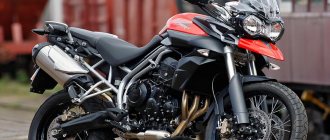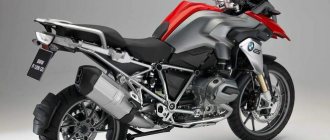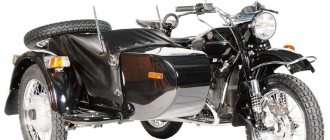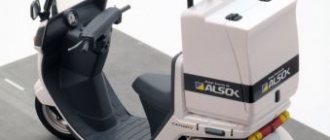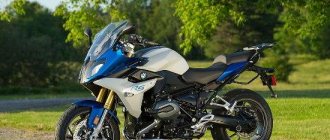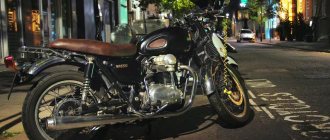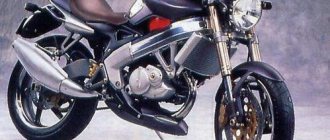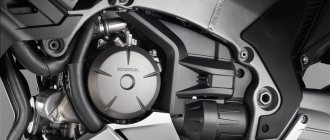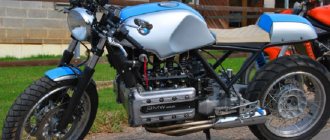Model class: touring enduro
Years of production/sales: 2004-
BMW R1200GS model appeared in March 2004 and became the successor to the BMW R1150GS model. The main changes affected the appearance and technical part:
- New engine : 1170cc, with balancer shaft, 100 (98 for the German market) hp. power and 115 Nm of torque.
- New injection system : BMS-K.
- New design : the design of the plastic, gas tank, and dashboard is changing.
- New ABS system : Since 2006, ABS II with electric booster has been replaced by the more reliable ABS III.
- Reduced curb weight : from 249 to 225 kg.
- New options : electronically adjustable suspension (ESA), stability control (ASC), traction control system - since 2008; LED headlights, keyless entry, quickshifter, security system - from 2014-2016.
In all other respects, the BMW R1200GS model has the classic features of BMW R-series motorcycles: a 2-cylinder boxer engine, proprietary Telelever and Paralever suspensions, cardan drive and ABS. In addition, the BMW R1200GS model has many touring options - heated grips, hand protection, standard saddlebag mounts, cruise control, etc.
Main modifications of the BMW R1200GS:
- BMW R1200GS – regular version. The standard version was sold with alloy wheels (spoke wheels are available as an option).
- BMW R1200GS Adventure – top version. Available since 2005. It features spoked wheels in the base, longer travel suspensions, a 33-liter fuel tank, as well as a windshield, protective linings on the cylinders, arches and plastic aerodynamic elements.
Main generations of BMW R1200GS:
- BMW R1200GS (2004-2007) – first generation. Models of these years produce from 98 (for the German market) to 100 hp. power and 115 Nm of torque.
- BMW R1200GS (2008-2009) – second generation. The compression ratio increases to 12.0:1, maximum power increases to 105 hp, versions with ABS II lose the electric brake booster. New options appear: ESA (electronic suspension adjustment) and ASC (traction control). The model is undergoing a slight restyling, changing the shape of the plastic on the tank, the design of the rims and some other visual elements.
- BMW R1200GS (2010-2012) – third generation. The engine receives a new cylinder head with two camshafts (DOHC), which increases the maximum speed to 8500 rpm and the maximum power to 110 hp. at 7750 rpm.
- BMW R1200GS (2013-) – fourth generation. The model receives a new liquid-cooled engine with 125 hp. power and 125 Nm of torque; updated appearance (small cosmetic differences, cantilever swingarm with cardan on the left side); new brakes with a larger diameter rear disc and radial mounted front calipers; increased tire size; new clutch (multi-disc slipper in an oil bath); curb weight increased by 9 kg; electronic throttle with 5 traction control modes; new generation Paralever rear suspension – EVO (swingarm length and ground clearance increased); non-adjustable hydraulic steering damper in stock. New electronic options - quick shifter, LED headlights, Keyless Ride, Dynamic ESA semi-active suspension, tire pressure monitoring system.
The current BMW R1200GS is BMW's flagship touring enduro, gaining popularity around the world. The model was repeatedly recognized as the motorcycle of the year and was the best-selling model in Europe and various countries.
In 2012, Cycle World magazine named the BMW R1200GS the "Most Successful Motorcycle of the Last 25 Years."
000_MOTO_1110_044
BMW R1200GS/R1200GS Adventure: tourenduro, 2004-present, 1170 cm³, 100 hp.
(2004–2009)/105 hp (2010-present), 350–900 thousand rubles. BMW R1200GS/R1200GS Adventure: tourenduro, 2004-present, 1170 cm³, 100 hp. (2004–2009)/105 hp (2010-present), 350–900 thousand rubles.
SWAN GEESE. Having appeared in 2004, the current generation of GSs changed a little only in 2010: they received an updated overhead motor (+5 hp), but otherwise the “goose” remained the same. Today there are more than 980 thousand species of birds in nature. As for the “geese,” only four species have been described recently: the junior F650GS, the mid-size F800GS, the senior R1200GS and its Adventure modification. We will talk about the “kids” another time, but now we will talk about the older opposite “geese”. “Adventure” differs from the usual one in the gas tank increased from 20 to 33 liters (which ensures a non-stop flight of up to 500 km), spoked rather than cast wheels, the presence of a tubular “cage” around the engine, as well as more developed wind protection. Other options (such as “electric” ESA suspensions, tire pressure sensors, heating, ABS and a great variety of external gadgets) are available on both models. So, after all, what should you look for when choosing, so that the external gloss and abundance of tuning do not mask the overall shabbiness of the car, or vice versa, so that the lack of “minced meat” does not deceive a “living” motorcycle in a new state?
BIRD'S HEART. In principle, the engine is indestructible: if it is not overheated and the oil is changed on time, it can easily survive two hundred thousand kilometers. However, even the pillars of reliability have weak points, and in this case, one is due to the layout - needless to say, the opposed engine is more afraid of falls than other motors hidden in the depths of the frame. There is no frame as such, and the cylinders stick out defiantly to the sides. Therefore, the first thing you should pay attention to when inspecting the engine is the virginity of the edges of the bolts, the absence of oil stains at the joints between the crankcase, cylinders and heads, and the external “knots” on the “pots”. When you listen to the engine, do not forget that even though it is noisy and “ventilated,” rhythmic metallic knocks equally hint at a diagnosis for any engine, regardless of the type of cooling.
As for the transmission, there are two weak points: the clutch and the rear tip. The clutch here is single-plate dry - like on cars, and it is just as easy to burn it - just a few “racing” starts from traffic lights at high speeds, and the characteristic smell of a scorched disk will not take long to appear. And if the clutch can somehow be diagnosed (it should not slip when the gas is sharply opened in higher gears), then the rear gearbox is unrealistic. The problem is that motorcycles manufactured before July 2006 suffer from the fact that in some cases the rear wheel hub bearing separator and, accordingly, the driven gear of the final drive suddenly fall apart. As a rule, the gears are chewed even before the owner notices something is wrong. This usually happens after a mileage of 20–30 thousand kilometers. For reference, the cost of rebuilding the “bridge” is about 15 kilo rubles, the assembled gearbox costs about a “ton” of euros. Someone will probably suggest shaking the rear wheel when it is hanging, but you will hardly be able to notice the play - the bearing dies instantly, without any symptoms. So it’s better to look for a newer car, or take a “goose” with an already replaced “bridge”.
HOW'S FEET. This is not a cake. This is the chassis. Everything here is as simple as it is atypical. Firstly, the main load-bearing element of a motorcycle is the motor. And the whole “hanging” is attached to it on tubular stretchers. Their integrity and straightness can be checked both by eye, placing the motorcycle on the center stand, and on the move, releasing the steering wheel on level asphalt: the motorcycle should stand and ride perfectly straight, it should not be led to the side, but the “tail” and the rear wheel should not be displaced relative to each other. In “adventure” vehicles, it is also worth inspecting the steel protective frame that encircles the engine for dents. In my memory, there was one “goose” whose engine was torn from the box after the frame hit a pine tree.
As for the suspensions, in addition to the integrity of the chrome on the fork stays and monoshock rods and the absence of oil stains on them, be sure to check the operation of the ESA system, if there is one - following the graphical display of the state of the shock absorbers, the suspensions should switch modes quickly, their change is noticeable by the change in the nature of behavior motorcycle. But there is hardly any need to be afraid of the current telelever feather seals - they are no more difficult to move than a classic fork design. It would be a good idea to check the ball joint of the lower yoke for play by hanging the front wheel and tugging the lower ends of the stays back and forth.
PLUMAGE. The time has come for the easiest part of the inspection - the external assessment.
The least thing you should pay attention to is the mounted tuning: “minced meat” is, of course, great only when installed on a “healthy” device, so it’s better not to take into account the enthusiastic stories of the seller about how he lost several salaries on “mulks” and proceed with the standard inspection. Everything here is the same as everyone else’s: bruised plastic, seriously chipped brake discs, scratches on the wheels from repeated tire mounting, abrasions on the steering wheel handles and seats are unlikely to tally with the 3,000 km mileage on the odometer. Also inspect the oil cooler in the “beak” for clogging - the abundance of dirt and debris in it hints at the specific use of the motorcycle. Last but not least, you should pay attention to errors if they “come out” after turning on the ignition - blinking or a constant glow of the icon on the display is a reason to go to the dealer for diagnostics. SUMMARY. Here, in fact, are all the nuances of choosing, perhaps, the most convenient enduro for travel. And in order for the “goose” to serve faithfully for a long time, you should monitor the cleanliness of the oil cooler, adjust the valve clearances in a timely manner, do not increase the interval for replacing consumables such as oil, filters, spark plugs, do not feed it with 76 gasoline and do not play traffic light races with sport bikers. And as for tuning, the “Golda” will be jealous of the abundance of all kinds of gadgets.
First impressions
So, the red R1200GSA, however, without the “body kit” in the form of panniers, but that’s not the point. Judging by further impressions, he’s completely clueless about what to hang on him—he’s rushing like a tank. But I'm getting ahead of myself. They explained to me the menu system where and how to play with the settings, set the “rain” mode to begin with and wished me good luck with the words “just don’t forget to give me the key.” Considering that you don’t need to insert the key anywhere, but simply keep it in your pocket (preferably with a zipper) - the advice is not without meaning. The only question that remained with me after all the explanations was “where is the best place to ride here, right?” As it turned out, the representative turned out to be “not local,” but somehow showed the way with his fingers. I still missed all the turns, but, at least conceptually, I was driving in the right direction.
We press the start button and the “beast” comes to life. Unlike previous models, there is no squeezing the clutch or other “tambourines”. Just make sure it doesn't stand in gear. We carefully taxi out of the parking lot (just not to drop it...) and here is the road.
009_MOTO_1110_049
Estimated cost of BMW R1200GS spare parts
| Name | Original spare parts, rub. | Non-original spare parts, rub. |
| Air filter | 800 | 650 (Mahle LX984/2) |
| Oil filter | 550 | 350 (Mann MW75 or Mahle OC306) |
| Front brake pads (for one disc) | 2700 | —- |
| Rear brake pads | 2400 | —- |
| Fork seals, (for one feather) | 550 | —- |
| Alternator drive belt | 900 | 250 (Gates 4pk580) |
| Spark plug, 1 piece | 460 | 450 (NGK DCPR8EKC) |
| Friction clutch disc | 6000 | —- |
| Fork ball joint | 4500 | —- |
| Spare parts, mostly available in stock. Spare parts are sometimes in stock. | ||
Choosing a used BMW R1200GS
Specifications
Engine: 4-stroke, 2-cylinder boxer Boxer with a capacity of 1170 cc. see Cooling: air-liquid since 2013, before that air-oil. Ignition: electronic. R1200 GS motorcycle gearbox: 6-speed. Drive: cardan. Tires: 110/80 ZR19, from 2013 - 120/70 R 19 (rear), 150/70 R17, from 2013 - 170/60 R 17 (front). Brakes: 2 discs, 305 mm, 4-piston calipers, semi-integral ABS II (front), 1 disc, 265 mm, 2-piston calipers, semi-integral ABS II (rear). Suspension: BMW Telelever (preload adjustable), travel - 190 mm (Adventure - 210 mm) at the front and pendulum BMW Paralever (compression and rebound adjustment, optional ESA), travel - 200 mm (Adventure - 220 mm) at the rear. Gas tank: 20 liters in the standard version and 33 liters in the Adventure version. Maximum acceleration speed of motorcycles: 208 km/h. Acceleration to 100 km/h: 3.4 seconds. Curb weight of motorcycles: 225 kg for the standard version and 256 kg for the Adventure version.
BMW R 1200 GS price
The BMW R 1200 GS Adventure 2022 has the most affordable price in its class compared to its competitors. New Racing red color scheme—red body, black frame, black calipers and silver fuel tank. Another Style Rallye option is a white and blue body with a blue frame, gold calipers, fuel tank logo, Rallye seat, radiator and frame guards and a low windshield. But if you want to add any of the long list of accessories to your new motorcycle, especially BMW Motorrad Connectivity, Dynamic ESA, be prepared for the price to start rising exponentially.
Landing
I didn’t feel any particular shock from switching to an SUV. There was even a slight disappointment, since I was expecting a “tank” in front of me, but in the end it felt like there was only a “slightly fat” motorcycle in front at the bottom (due to the huge tank), and nothing particularly outstanding. Probably, the size of the tidy and the windshield smooth out the impressions. Well, okay.
The seat is quite hard (as it should be, apparently, in an “adventure game”), but at the same time quite spacious, with a certain freedom of movement “to move around” on a long journey.
What I immediately felt was a more comfortable position for the legs - on RT you have to bend your legs, and as a result, the position below the waist is “locked”, even with the seat elevated. The R1200GS(A) with the 890/910mm seat that I got has a semi-standing stance feel that leaves my legs feeling fairly free. In general, I liked it, although after me a young lady who was slightly shorter in stature tried it on, she even looked at the shorter model with great doubt. Many Dutch GS owners cite the “Bavarian” size as the reason for their choice (besides branding, etc.), which allows people of “normal height” to fit comfortably on it.
BMW R 1200GS
The Bavarian manufacturer has always been a leader in the touring motorcycle market. For 35 years, GS bikes have single-handedly ruled this segment. And the top line of the hit parade is occupied by the flagship BMW R 1200 GS Adventure. And, undoubtedly, the two-cylinder boxer engine will be your best companion in conquering the unknown. And in 2022, with the factory-tuned BMW Motorrad R 1200 GS Adventure, you can explore even the most hidden corners. The new Adventure version, with its new instrument panel, Emergency Call function and new color scheme, showcases advanced technology under the name of the first generation GS.
2018 BMW R 1200 GS
Appearance and Design
A few words about appearance. It is clear that there is no arguing about tastes. It took me a long time to get used to the appearance of the GS series, and only after 10 years of owning motorcycles I began to “get into the subject.” GSA adds a more “menacing” appearance with a large gas tank, plastic “air intakes” on the tank (which, by the way, play in the grooves - “shame and disgrace”), the presence of spoked wheels and “cross” running boards (which, to their credit, have vibrations you can't feel it!).
